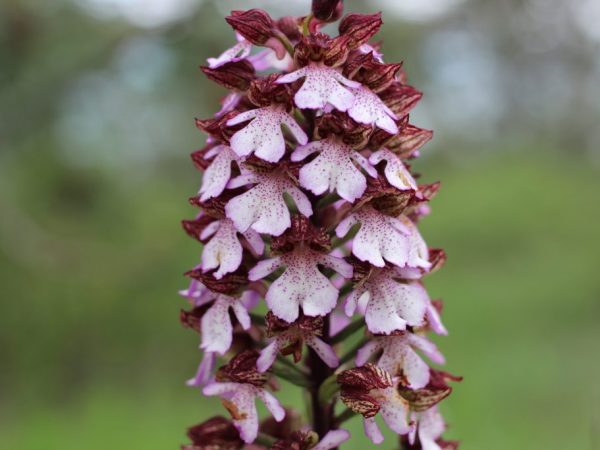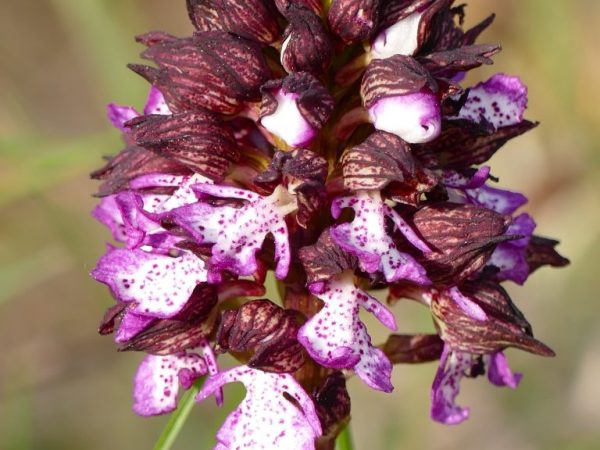Lyubka is two-leaved
Lyubka two-leaved is a perennial herb from the orchid family, which has become widespread in folk medicine due to its medicinal properties.

Lyubka is two-leaved
Botanical characteristic
Refers to tuberous decorative wild plants of the genus Lyubka. It is also grown as a horticultural crop. Lyubka two-leaved has several synonymous names:
- wild balm,
- night violet,
- love root,
- cuckoo tears.
The scientific name Platanthera consists of 2 Greek words, translated as "wide pollen sac", which is associated with the appearance of the plant. The anther of Lubka double-leaved looks like a bag for collecting pollen.
The popular name lyubka, like a flower, was given due to its magical properties: according to legend, its tubers were used as a love potion and love potion.
According to the description, the plant grows to a height of 0.2-0.5 m, in rare cases - up to 0.6 m, has 2 connected pear-shaped root tubers. The stem is thickened towards the root end. Pairs of basal leaves are located opposite each other, light green, with their characteristic gloss. The length of the leaf blade is 8-22 cm, the width is 3-6 cm. Stem leaves are small, sessile.
The length of the inflorescences is 0.2 m, they are formed in the form of an ear of 8-40 white flowers with a slight yellow tint. The plant has a pleasant aroma, the concentration of which increases in the evening and at night or on a cloudy day, hence the name - night violet. The beginning of the flowering stage is 6-7 years. The flowering period is early and mid-summer.
Growing places
The growing areas are limited to the middle zone of the central part of Russia, the western and eastern territories of Siberia. Lyubka two-leaved is also present in the region of Asia Minor, in Altai, in the Sayan Mountains and the Caucasian regions.
Due to the massive collection as a decorative flower in some regions, the plantings have disappeared completely, therefore it is listed in the Red Book as a species of the orchid family that requires protection.
Lyubka two-leaved prefers illuminated forest glades, grows among grass on the edges of deciduous, coniferous and mixed forests, is found among shrub thickets, in forest-steppes and mountain ranges, grows on poor moist soils.
Spread by seeds carried by the wind. Dependent on fungal mycelium, in the presence of which seeds germinate.
Chemical composition

Orchid is used for medicinal purposes
The tubers contain a significant amount of mucus (about 50%), which contains the plant polysaccharide mannan. Starch content - up to 27%. The rest is occupied by sugar, protein components, mineral salts, essential oils, calcium oxalate and bitter substances.
Pharmacology
A number of medicinal properties of the night violet Lubka:
- enveloping,
- antitoxic,
- tonic,
- anti-inflammatory,
- antiseptic,
- diuretics.
Due to the chemical composition of mucus, the plant helps to lower blood pressure, is able to protect the mucous membranes of the stomach and intestines from the irritating effects of substances entering them,becomes an obstacle to the absorption of toxins. Two-leaved tubers (salepa) are known in alternative medicine as a means of increasing sexual activity.
Scope of application
Lyubka is used in interior and landscape design, medicine and cooking.
Floriculture
Lyubka two-leaved is widely used in interior landscape design as a highly decorative plant. It is grown in greenhouses and as a garden decoration. Compositions with flowers of any kind are used when decorating the interior of premises.
Cooking
From the dried tubers of lyubka bifold, containing many useful components, they make nutritious drinks and products:
- a drink known among eastern peoples called kokuya consists of tubers, ground to a state of flour, boiled with honey,
- salep insist on wine or broth, using it as a strength-supporting product,
- Caucasian peoples use tubers in the preparation of first courses, make flour and jelly on their basis.
The medicine
The plant is not included in the collection of the State Pharmacopoeia of the Russian Federation, therefore it is not used in official medicine. The main application of Lyubka bilifolia is found in folk medicine.
The therapeutic raw material is mainly tubers, which are harvested at the end of the flowering process or at its last stages. The most fleshy and juicy tubers are cleaned, washed and placed in boiling water for 2-3 minutes, dried in an oven at 50 ° C or in a dark place. Ready-to-use tubers should be firm and horny, light yellow in color, odorless and bitter.
With diseases of the gastrointestinal tract
For diseases of the stomach and disorders of the intestinal tract, decoctions are used based on the roots and tubers of lyubka two-leaved (10 g of dry lyubka per 200 ml of water), including:
- in cases of diarrhea and discharges of various etiologies;
- with intestinal colitis;
- against gastritis and enteritis.
Genitourinary sphere
Tuberous decoctions are used in inflammatory processes of the genitourinary sphere, including inflammation of the bladder, gynecological diseases.
Respiratory system
A root-based drink with honey is recommended for diseases of the respiratory system, including a lingering cough.
External use
Tubers, crushed and infused with milk, mixed with pork fat, are used by folk medicine as an external remedy against abscesses and abscesses.
Dosage
With the above diagnoses and symptoms, the internal use of decoctions of 1 tbsp is prescribed. l. 3 times a day. For children, on the basis of two-leaved tubers, mucus is prepared, appointing 1 tsp. 2-3 times a day. When preparing mucus, dried tubers are crushed to a powdery state. 2 g of powder is poured into a glass of boiling water, shaken for 10-15 minutes. until the formation of colorless mucus of a thick consistency.
Conclusion
Lyubka double-leaved, a member of the orchid family, has found wide application in floriculture, due to its easy care during cultivation. It is used in interior and landscape design for decorating rooms and garden areas. Thanks to the useful components included in its chemical composition, the night violet has become a popular remedy in folk medicine. Among the eastern peoples, it is also used in cooking. The plant is listed in the Red Book.


